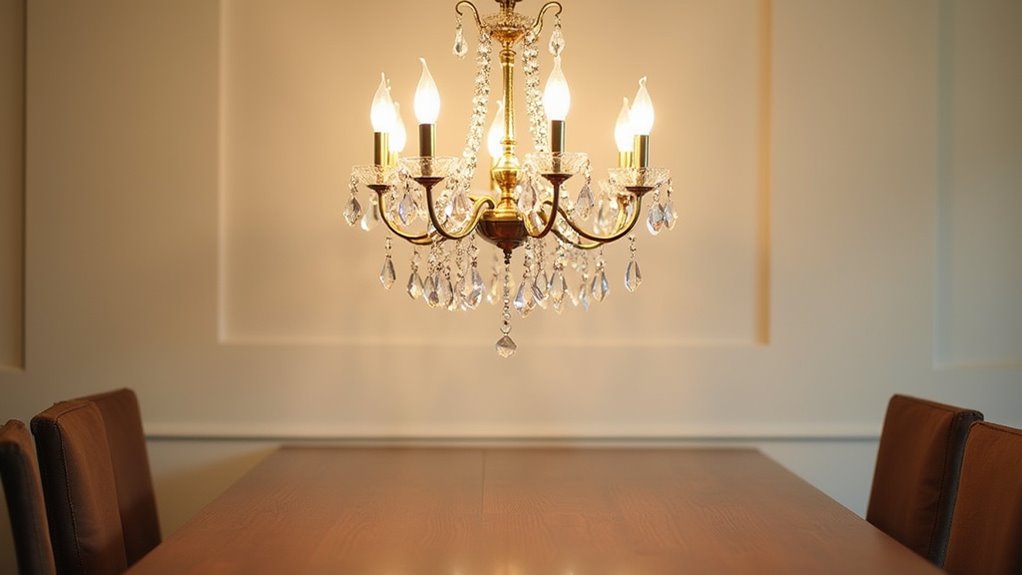Selecting the perfect dining room light fixture requires precise coordination between aesthetic style, dimensional proportions, and functional illumination. The fixture diameter should measure 50-66% of the table’s width, suspended 30-36 inches above the surface. Optimal brightness ranges from 30-40 lumens per square foot with warm-white temperatures between 2700K-3000K. Metal finishes must coordinate with existing room elements while construction materials like stainless steel ensure durability. Proper installation assessment and maintenance protocols complete the selection process for comprehensive lighting solutions.
Key Takeaways
- Choose a fixture style that complements your dining room’s aesthetic, whether traditional chandeliers or modern pendant lights.
- Size the fixture diameter to 50-66% of your table width and hang 30-36 inches above the tabletop.
- Aim for 30-40 lumens per square foot with warm-white temperature (2700K-3000K) for comfortable dining ambiance.
- Select durable materials like stainless steel or tempered glass that will maintain their appearance over time.
- Plan proper installation by assessing structural support, electrical requirements, and establishing regular maintenance protocols.
Selecting the Right Style to Match Your Decor
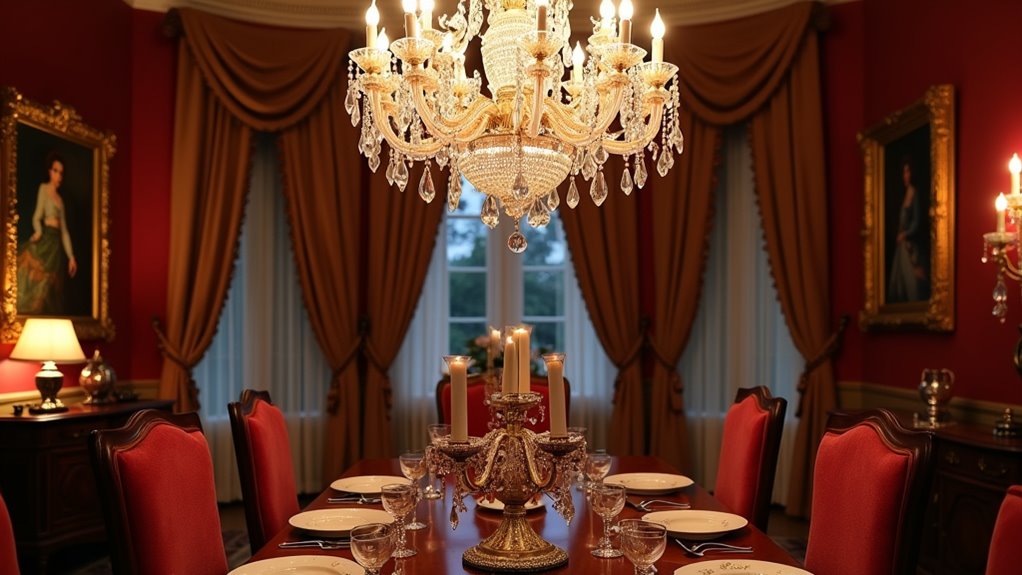
When establishing visual coherence in dining room design, the light fixture must align with the space’s dominant aesthetic language to achieve seamless integration. Chandeliers offer extensive versatility across style spectrums, from traditional elegance to contemporary minimalism, accommodating diverse decorating schemes.
Light fixtures serve as pivotal design anchors, demanding careful alignment with the dining room’s established aesthetic vocabulary for unified visual impact.
Pendant lights deliver distinctly modern aesthetics while enabling strategic fixture combinations through varied sizes and configurations for enhanced visual dynamics. Geometric linear LED pendant systems embrace minimalist aesthetics with clean rectangular forms that align with various interior design schemes.
Wall sconces function as dual-purpose elements, providing both illumination and decorative accent pieces when properly coordinated with ceiling fixtures. Many dining rooms benefit from artistic wall lighting that incorporates luxe materials and interesting silhouettes to create sophisticated focal points.
Critical to decor harmony is the correspondence between metal finishes and existing room elements, including furniture hardware and decorative accents. This systematic approach ensures unified design continuity throughout the space. Recessed ceiling lights provide sleek ambient lighting that complements other fixtures without compromising the room’s aesthetic flow.
Whether selecting rustic wrought iron for farmhouse themes or polished chrome for contemporary settings, material choices must reinforce the established design vocabulary for optimal aesthetic cohesion.
Determining Proper Fixture Size and Placement for Your Table
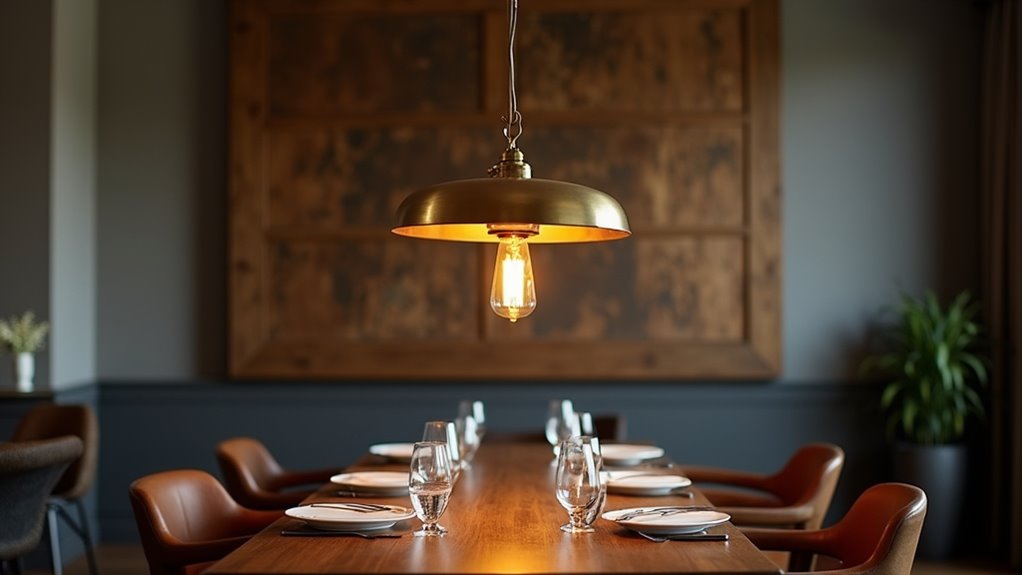
Beyond aesthetic coordination, precise dimensional relationships between lighting fixtures and dining tables form the foundation of successful dining room illumination design.
Optimal fixture diameter ranges between 50% to 66% of the table’s width, with fixture shape and table type determining specific proportional calculations. For rectangular configurations, fixture length should measure approximately 12 inches shorter than table length, while round fixtures require diameter measurements based on table width for harmonious integration.
Standard suspension height maintains 30-36 inches from tabletop to fixture bottom, ensuring unobstructed sightlines and effective light distribution. For dining rooms with ceiling heights above eight feet, adjust the hanging height by adding three inches for each additional foot of ceiling height to maintain proper proportional balance.
Perfect centering over the table’s midpoint eliminates shadow irregularities and maintains visual equilibrium.
- Transform intimate dinners into perfectly illuminated experiences with professionally calculated proportions
- Eliminate awkward lighting gaps that diminish dining ambiance and conversation flow
- Achieve designer-level sophistication through mathematically precise fixture-to-table relationships
Optimizing Light Quality and Brightness Levels
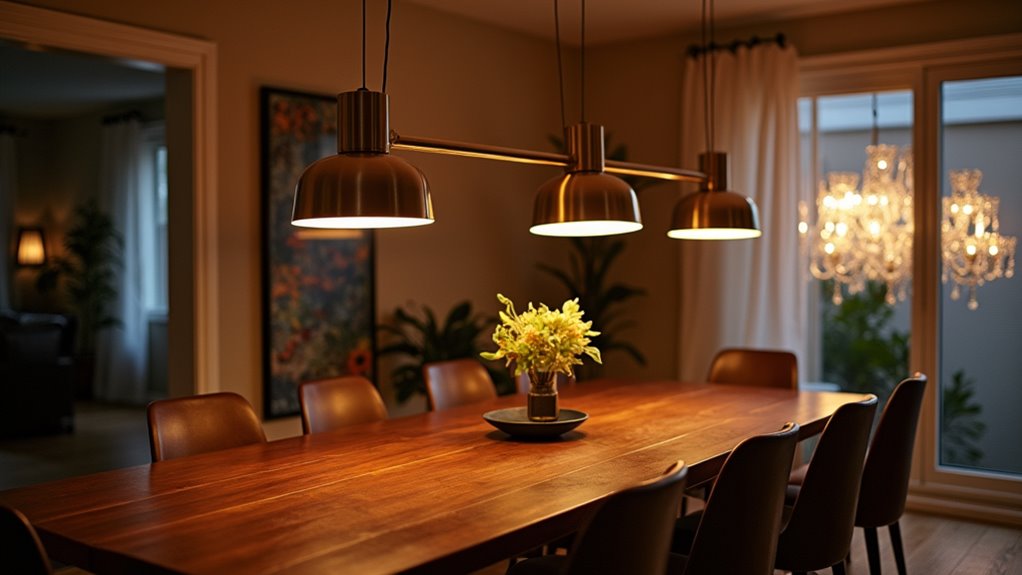
Successful dining room illumination depends on achieving precise brightness calculations that balance functional requirements with atmospheric comfort.
Professional designers recommend 30-40 lumens per square foot for standard dining environments, escalating to 50-60 lumens for task-intensive applications. A 100-square-foot dining room requires approximately 3,000-4,000 total lumens distributed across multiple lighting layers.
Effective illumination strategies incorporate three distinct components: ambient lighting providing foundational coverage through chandeliers or flush mounts, task lighting delivering 500-800 lumens for focused dining activities, and accent lighting reducing glare while enhancing atmospheric subtlety.
Color temperature selection proves critical, with warm-white ranges of 2700K-3000K optimizing comfort and food presentation aesthetics.
Dimmer controls enable dynamic brightness modulation, accommodating diverse functional requirements from bright meal preparation to intimate evening dining.
High color rendering index ratings of 98+ ensure accurate color reproduction throughout varying illumination levels.
Advanced dimming technology allows precise control over brightness levels, with some systems capable of adjusting output down to as low as 1% for ultimate atmosphere customization.
Choosing Durable Materials and Quality Construction

While optimal illumination establishes the functional foundation of dining room lighting, material selection and construction quality determine long-term performance and aesthetic preservation.
Material durability hinges on selecting appropriate substrates for environmental conditions. Stainless steel and powder-coated metals resist corrosion and moisture exposure, while tempered glass provides superior shatter resistance. Natural stone materials like marble and travertine offer exceptional longevity with proper installation support.
Construction quality encompasses manufacturing precision, joint integrity, and finish application. Durable craftsmanship requires corrosion-resistant fasteners, reinforced mounting points, and professional-grade protective coatings. Multi-material fixtures demand engineered integration methods to maintain structural stability.
- Premium materials transform dining spaces into lasting design statements that withstand decades of family gatherings
- Superior construction quality protects investment value while ensuring safety for loved ones
- Thoughtful material selection creates heirloom pieces that enhance home legacy
Planning Installation and Maintenance Requirements
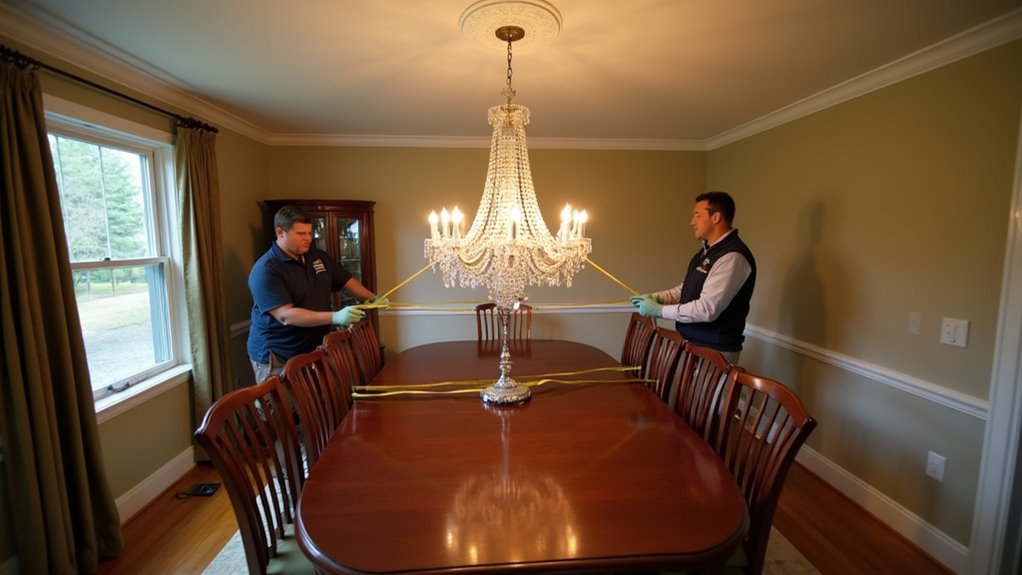
Installation planning requires systematic assessment of structural support capacity, electrical infrastructure compatibility, and ongoing maintenance accessibility.
Essential safety precautions include circuit breaker deactivation, voltage testing verification, and protective equipment utilization during fixture mounting procedures.
Safety protocols mandate complete power disconnection, thorough voltage verification, and proper protective gear before commencing any electrical fixture installation work.
Professional installation tools encompass voltage testers, wire strippers, power drills, and appropriate ladder equipment for ceiling access.
Proper positioning demands precise measurements: fixtures positioned 30-36 inches above table surfaces, with diameter specifications ranging one-half to two-thirds table length.
Electrical connections require methodical ground, neutral, and line wire attachment using approved wire nuts and secure electrical box integration.
Maintenance protocols involve regular cleaning schedules, connection inspections, immediate bulb replacement, and hardware tension verification.
Strategic planning addresses long-term accessibility requirements, ensuring efficient servicing capabilities while maintaining optimal illumination performance throughout the fixture’s operational lifespan.
